初中英语句子结构句子成分讲解
初中英语句子结构句子成分讲解
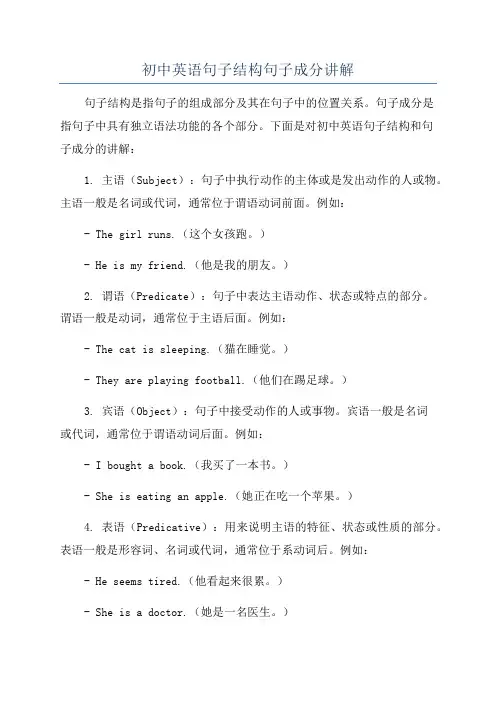
初中英语句子结构句子成分讲解句子结构是指句子的组成部分及其在句子中的位置关系。
句子成分是指句子中具有独立语法功能的各个部分。
下面是对初中英语句子结构和句子成分的讲解:1. 主语(Subject):句子中执行动作的主体或是发出动作的人或物。
主语一般是名词或代词,通常位于谓语动词前面。
例如:- The girl runs.(这个女孩跑。
)- He is my friend.(他是我的朋友。
)2. 谓语(Predicate):句子中表达主语动作、状态或特点的部分。
谓语一般是动词,通常位于主语后面。
例如:- The cat is sleeping.(猫在睡觉。
)- They are playing football.(他们在踢足球。
)3. 宾语(Object):句子中接受动作的人或事物。
宾语一般是名词或代词,通常位于谓语动词后面。
例如:- I bought a book.(我买了一本书。
)- She is eating an apple.(她正在吃一个苹果。
)4. 表语(Predicative):用来说明主语的特征、状态或性质的部分。
表语一般是形容词、名词或代词,通常位于系动词后。
例如:- He seems tired.(他看起来很累。
)- She is a doctor.(她是一名医生。
)5. 定语(Attributive):用来修饰名词或代词的部分。
定语可以是形容词、副词、名词、介词短语等,通常位于被修饰词的前面。
例如:- The blue car is mine.(那辆蓝色的车是我的。
)- The boy in the red shirt is my brother.(穿红衣服的男孩是我弟弟。
6. 状语(Adverbial):用来修饰动词、形容词、副词或整个句子的部分。
状语可以是副词、介词短语、从句等,通常位于句子中的任何位置。
例如:- He runs fast.(他跑得快。
)- They went to the park yesterday.(他们昨天去了公园。
初中英语句子结构和句型分析及细致讲解
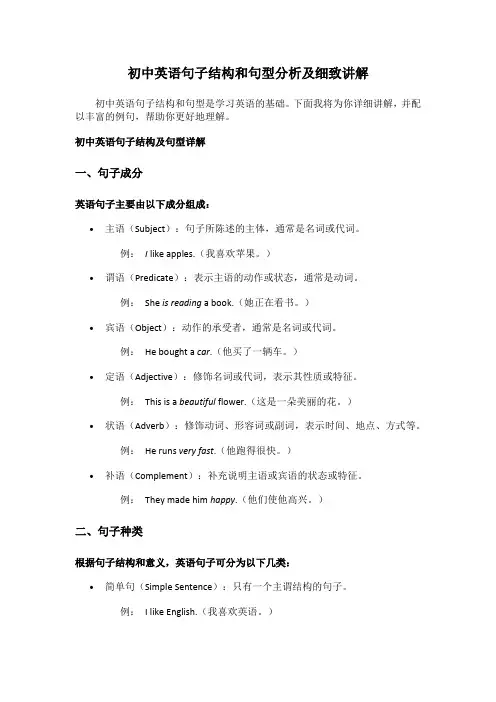
初中英语句子结构和句型分析及细致讲解初中英语句子结构和句型是学习英语的基础。
下面我将为你详细讲解,并配以丰富的例句,帮助你更好地理解。
初中英语句子结构及句型详解一、句子成分英语句子主要由以下成分组成:•主语(Subject):句子所陈述的主体,通常是名词或代词。
例:I like apples.(我喜欢苹果。
)•谓语(Predicate):表示主语的动作或状态,通常是动词。
例:She is reading a book.(她正在看书。
)•宾语(Object):动作的承受者,通常是名词或代词。
例:He bought a car.(他买了一辆车。
)•定语(Adjective):修饰名词或代词,表示其性质或特征。
例:This is a beautiful flower.(这是一朵美丽的花。
)•状语(Adverb):修饰动词、形容词或副词,表示时间、地点、方式等。
例:He runs very fast.(他跑得很快。
)•补语(Complement):补充说明主语或宾语的状态或特征。
例:They made him happy.(他们使他高兴。
)二、句子种类根据句子结构和意义,英语句子可分为以下几类:•简单句(Simple Sentence):只有一个主谓结构的句子。
例:I like English.(我喜欢英语。
)•并列句(Compound Sentence):由两个或两个以上的简单句用并列连词(and, but, or等)连接而成。
例:I like apples, and she likes bananas.(我喜欢苹果,她喜欢香蕉。
)•复合句(Complex Sentence):由一个主句和一个或多个从句组成。
例:When I go home, I will do my homework.(当我回家时,我将做作业。
)三、句子类型•陈述句(Declarative Sentence):用来陈述事实或观点。
例:He is a student.(他是一个学生。
(完整)初中英语句子成分讲解
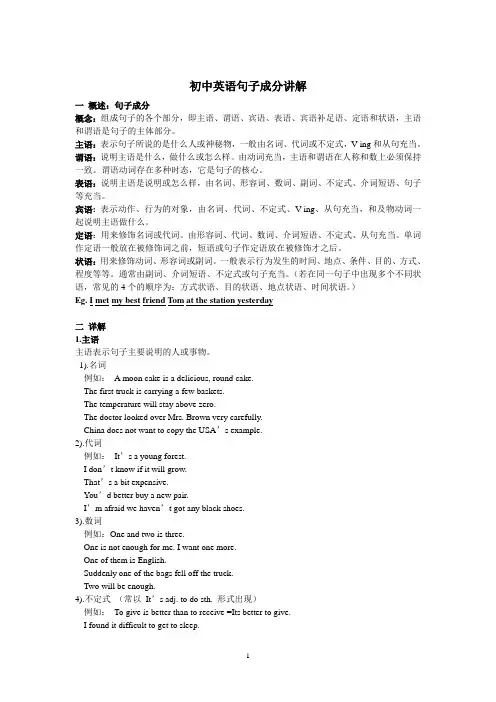
初中英语句子成分讲解一概述:句子成分概念:组成句子的各个部分,即主语、谓语、宾语、表语、宾语补足语、定语和状语,主语和谓语是句子的主体部分。
主语:表示句子所说的是什么人或神秘物,一般由名词、代词或不定式,V-ing和从句充当。
谓语:说明主语是什么,做什么或怎么样。
由动词充当,主语和谓语在人称和数上必须保持一致。
谓语动词存在多种时态,它是句子的核心。
表语:说明主语是说明或怎么样,由名词、形容词、数词、副词、不定式、介词短语、句子等充当。
宾语:表示动作、行为的对象,由名词、代词、不定式、V-ing、从句充当,和及物动词一起说明主语做什么。
定语:用来修饰名词或代词。
由形容词、代词、数词、介词短语、不定式、从句充当。
单词作定语一般放在被修饰词之前,短语或句子作定语放在被修饰才之后。
状语:用来修饰动词、形容词或副词。
一般表示行为发生的时间、地点、条件、目的、方式、程度等等。
通常由副词、介词短语、不定式或句子充当。
(若在同一句子中出现多个不同状语,常见的4个的顺序为:方式状语、目的状语、地点状语、时间状语。
)Eg.I met my best friend Tom at the station yesterday二详解1.主语主语表示句子主要说明的人或事物。
1).名词例如:A moon cake is a delicious, round cake.The first truck is carrying a few baskets.The temperature will stay above zero.The doctor looked over Mrs. Brown very carefully.China does not want to copy the USA’s example.2).代词例如:It’s a young forest.I don’t know if it will grow.That’s a bit expensive.You’d better buy a new pair.I’m afraid we haven’t got any black shoes.3).数词例如:One and two is three.One is not enough for me. I want one more.One of them is English.Suddenly one of the bags fell off the truck.Two will be enough.4).不定式(常以It’s adj. to do sth. 形式出现)例如:To give is better than to receive =Its better to give.I found it difficult to get to sleep.It’s glad to see you again.It was difficult to see.But it’s good to swim in summer.5).动名词Swimming is interesting.Reading books is good for us.6).名词化的形容词做主语The blind need more help.7).句子作主语What he has said is true.8).It作主语,有如下情况:1)指代刚刚提到的事物:What’s this ? It’s a bus. (指代what)2)指代一个你不知道或判断不清性别的人Who’s knocking the door? It’s me. (指代who) Who’s the baby in the picture? It’s my sister. (指代who)3) 表示时间,天气,距离:What’s the time? It’s eight o’clock. (时间)What’s it going to be tomorrow? It’s going to be rainy.(天气)How far is it? It’s about one kilometer away. (距离)6.there 引起的There be 句型中,be 作谓语,主语位居其后。
初中英语语法——句子成分
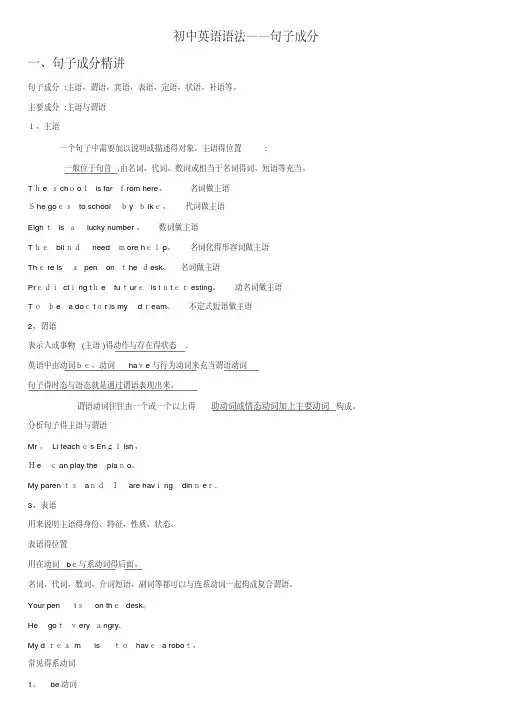
初中英语语法——句子成分一、句子成分精讲句子成分:主语、谓语、宾语、表语、定语、状语、补语等。
主要成分:主语与谓语1、主语一个句子中需要加以说明或描述得对象。
主语得位置:一般位于句首,由名词、代词、数词或相当于名词得词、短语等充当。
The schoolis far from here、名词做主语She goesto schoolby bike、代词做主语Eightis alucky number。
数词做主语Theblindneedmore help。
名词化得形容词做主语There isapen on the desk、名词做主语Predicting the futureis interesting。
动名词做主语Tobe a doctor is my dream、不定式短语做主语2、谓语表示人或事物(主语)得动作与存在得状态.英语中由动词be、动词have与行为动词来充当谓语动词句子得时态与语态就是通过谓语表现出来。
谓语动词往往由一个或一个以上得助动词或情态动词加上主要动词构成。
分析句子得主语与谓语Mr。
Li teaches English、Hecan play the piano。
My parentsandIare having dinner.3、表语用来说明主语得身份、特征、性质、状态、表语得位置用在动词be与系动词得后面。
名词、代词、数词、介词短语、副词等都可以与连系动词一起构成复合谓语。
Your pen ison thedesk。
He gotvery angry.My dream istohave a robot、常见得系动词1。
be动词2、与感觉有关得动词look, sound, smell,taste, feel 等3。
表示状态变化得动词,意为“变得" “变成” 如get,grow, turn等上述两类词作连系动词时要用形容词作表语,千万不能用副词、4、宾语就是动作得对象或承受者、及物动词必须跟宾语。
初中英语句子成分及简单句结构
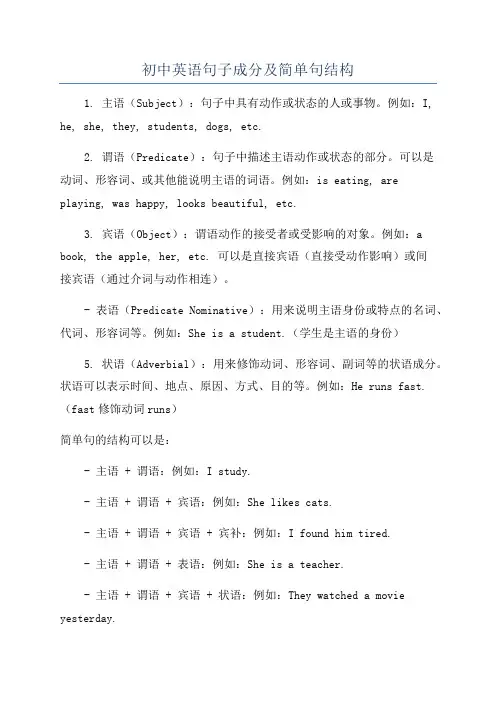
初中英语句子成分及简单句结构1. 主语(Subject):句子中具有动作或状态的人或事物。
例如:I, he, she, they, students, dogs, etc.2. 谓语(Predicate):句子中描述主语动作或状态的部分。
可以是动词、形容词、或其他能说明主语的词语。
例如:is eating, are playing, was happy, looks beautiful, etc.3. 宾语(Object):谓语动作的接受者或受影响的对象。
例如:a book, the apple, her, etc. 可以是直接宾语(直接受动作影响)或间接宾语(通过介词与动作相连)。
- 表语(Predicate Nominative):用来说明主语身份或特点的名词、代词、形容词等。
例如:She is a student.(学生是主语的身份)5. 状语(Adverbial):用来修饰动词、形容词、副词等的状语成分。
状语可以表示时间、地点、原因、方式、目的等。
例如:He runs fast.(fast修饰动词runs)简单句的结构可以是:- 主语 + 谓语:例如:I study.- 主语 + 谓语 + 宾语:例如:She likes cats.- 主语 + 谓语 + 宾语 + 宾补:例如:I found him tired.- 主语 + 谓语 + 表语:例如:She is a teacher.- 主语 + 谓语 + 宾语 + 状语:例如:They watched a movie yesterday.- 主语 + 谓语 + 宾语 + 宾补 + 状语:例如:He made his mother proud with his achievements.注意:这只是初中英语句子结构的基本介绍,实际句子可能更复杂,会涉及到从句、并列结构等。
此外,句子的成分也会根据句型和句意的需要而变化。
初中英语句子成分讲解简单明了附练习答案
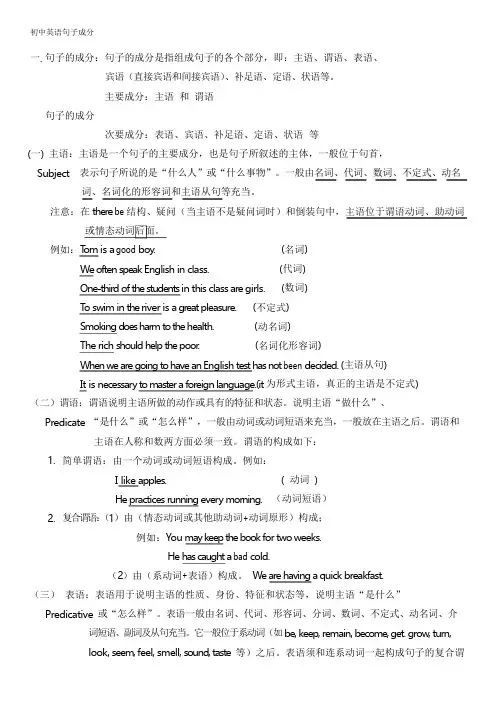
初中英语句子成分一.句子的成分:句子的成分是指组成句子的各个部分,即:主语、谓语、表语、宾语(直接宾语和间接宾语)、补足语、定语、状语等。
主要成分:主语和谓语句子的成分次要成分:表语、宾语、补足语、定语、状语等(一)主语:主语是一个句子的主要成分,也是句子所叙述的主体,一般位于句首,Subject表示句子所说的是“什么人”或“什么事物”。
一般由名词、代词、数词、不定式、动名词、名词化的形容词和主语从句等充当。
注意:在there be结构、疑问(当主语不是疑问词时)和倒装句中,主语位于谓语动词、助动词或情态动词后面。
例如:T om is a good boy.(名词)W e o ften speak English in class.(代词)One-third of the students in this class are girls.(数词)T o swim in the river is a gr eat pleasure.(不定式)Smoking do e s harm t o the health.(动名词)The rich should help the poor.(名词化形容词)When we are going to have an English test has no t been decided.(主语从句)It is necessary to master a foreign language.(it为形式主语,真正的主语是不定式)(二)谓语:谓语说明主语所做的动作或具有的特征和状态。
说明主语“做什么”、Predicate“是什么”或“怎么样”,一般由动词或动词短语来充当,一般放在主语之后。
谓语和主语在人称和数两方面必须一致。
谓语的构成如下:1.简单谓语:由一个动词或动词短语构成。
例如:I like apples.(动词)He practices running every morning.(动词短语)2.复合谓语:(1)由(情态动词或其他助动词+动词原形)构成;例如:Y ou may k eep the book for two weeks.He has caught a bad cold.(2)由(系动词+表语)构成。
(完整版)初中英语句子成分讲解_练习及答案
(完整版)初中英语句⼦成分讲解_练习及答案句⼦成分及基本句型⼀、考点、热点回顾【句⼦的成分】在英⽂中句⼦成分包括:主语、谓语、宾语(直接宾语、间接宾语)、表语、定语和状语、宾语补⾜语等。
(⼀)主语:主语是谓语讲述的对象,表⽰所说的“是什么”或“是谁”。
⼀般由名词、代词、不定式或相当于名词的词或短语来充当。
它在句⾸。
如:(1)Lucy is a beautiful nurse. (名词作主语)(2)He reads newspapers every day. (代词作主语)(3)Smoking is harmful to the health. (动名词作主语)(4)To swim in Kunming Lake is a great pleasure.(不定式作主语)(5)What we should do is not yet decided. (主语从句作主语)(⼆)谓语说明主语“做什么”“是什么”或“怎么样”。
谓语(谓语部分⾥主要的词)必须是动词。
谓语和主语在⼈称和数两⽅⾯必须⼀致。
它在主语后⾯。
如:His parents are teachers. (系动词和表语⼀起作谓语)We study hard. (⾏为动词作谓语)We don’t finish reading the book. (助动词和⾏为动词⼀起作谓语)He can speak English. (情态动词和⾏为动词⼀起作谓语)(三)宾语宾语是动作、⾏为的对象,由名词、代词、不定式或相当于名词的词、短语来担任,它和及物动词⼀起说明主语做什么。
⼀般放在谓语之后。
She is doing her homework now.(名词作宾语)She says(that)she is ill.(宾语从句作动词宾语)We often help him.(代词作宾语)He likes to play basketball.(不定式作宾语)We enjoy listening to the music. 我们喜欢听⾳乐。
初中英语句子结构和句子成分解析
英语句子成分和句子结构一、英语各种成分的基本含义及用法(一)、主语主语是全句谈论的中心话题。
我们在说一句话的时候,首先要明确我们讲的是“哪个人”?或者是一件“什么事”?或者是一件“什么物体”,等。
这些代表“哪个人”、“什么事”、“什么物体”等的部分就是句子的主语。
主语是指句子的某个部分,它可能是一个词,也可能是一个词组,还有可能是一个从句,甚至一句话中会有几个并列的主语等等。
所以,英语中很多词类(或词组、从句)都可以做主语。
另外,英语中还有一种特殊的主语形式叫“形式主语”,例如:It .... that ...句式等。
1. Peter is a well-known pianist. (名词作主语)2. Two-thirds of the students are boys in our school. ( 数词词组作主语)3. He likes reading storybooks. (代词作主语)4. To swim in Kunming Lake is a great pleasure. (不定式短语作主语)5. What we shall do next is not yet decided. (从句作主语)6. It took us two hours to travel around the city by subway.(It 是形式主语, to travel...部分是真正的主语)请指出下列句中主语的中心词。
1. The teacher with two of her students is walking into the classroom.2. There is a bird flying in the sky.3. The useful dictionary was given by my mother last year.4. It is very difficult to do today's homework without your help.(二)、谓语在明确了主语后,我们再来说谓语。
初中英语句子成分讲解解析
初中英语句子成分讲解一、句子成分组成句子的各个部分,即主语、谓语、宾语、表语、宾语补足语、定语和状语,主语和谓语是句子的主体部分。
二、详解●主语主语是一个句子的主要成分,也是句子所叙述的主体,一般位于句首。
它表示句子主要说明的人或事物,一般由名词、代词、数词、不定式、动名词或名次化的形容词等充当。
1.名词:The car is running fast. Tom is a good boy.2.代词:We are students. This is my pen. Yours is on the desk.3.数词:One of my classmates is from Shanghai. Two and three is five.4.不定式(常以 It’s adj. to do sth. 形式出现,it作形式主语,真正的主语是不定式)To give is better than to receive =It is better to give than to receive.To swim in the river is a great pleasure.5.动名词:Smoking is harmful to the health.6.名词化的形容词:The rich should help the poor.补充:1. it做主语,有如下情况:1) 指代刚刚提到的事物:What’s this? It’s a bus. (指代what)2) 指代一个你不知道或判断不清性别的人Who’s knocking the door? It’s me. (指代 who)Who’s the baby in the picture? It’s my sister. (指代 who)3) 表示时间、天气、距离What’s the time? It’s eight o’clock. (时间)What’s it going to be tomorrow? It’s going to be rainy.(天气)How far is it? It’s about one kilometer away. (距离)2.THERE 引起的There be 句型中,be 作谓语,主语位居其后。
初中英语句子成分及简单句结构
初中英语句子成分及简单句结构一般认为句子成分包括主语、谓语、宾语、表语、定语、状语及补语等七种成分。
1.主语作用:说明句子的中心。
构成:名词、代词、数词、不定式、动名词主语从句。
位置:句首Betty likes her new bike.(名词)。
They usually go to school on foot. (代词)。
Two and two is four. (数词)To learn a foreign language is not easy. (动词不定式短语)Playing basketball after school is great fun. (动名词短语)That the earth runs around the sun is known to everyone. (主语从句)It is known to everyone that the earth runs around the sun. (主语从句)2.谓语作用:说明主语做什么,是什么,怎么样。
构成:实义动词、连系动词、情态动词及助动词。
情态动词和助动词不能单独充当谓语,它们必须和实义动词或系动词一起构成谓语。
实义动词包括及物动词和不及物动词,及物动词后要带宾语。
位置:位于主语之后。
They work very hard. (行为动词)Tom is a student. Tom is handsome.(系动词+表语)We can speak English very well. (情态动词+实义动词)They are playing over there. (助动词+实义动词)3.宾语作用:表示动作的对象或承受着。
构成:名词、代词、数词、动词不定式、动名词以及宾语从句。
位置:动词或介词之后Tom bought a storybook last week. (名词)----How many books do you want?----I want seven. (数词)He wanted to have a cup of tea. (动词不定式短语)He enjoys playing basketball. (动名词短语)Our teacher said that he would go there. (宾语从句)有些动词需要带两个宾语,一个是直接宾语,另一个是间接宾语。
- 1、下载文档前请自行甄别文档内容的完整性,平台不提供额外的编辑、内容补充、找答案等附加服务。
- 2、"仅部分预览"的文档,不可在线预览部分如存在完整性等问题,可反馈申请退款(可完整预览的文档不适用该条件!)。
- 3、如文档侵犯您的权益,请联系客服反馈,我们会尽快为您处理(人工客服工作时间:9:00-18:30)。
主+ 谓 + 表
3. We don’t beat children.
主+ 谓 +
宾
4. He gave his sister the piano.
主 + 谓 + 间接宾语 + 直接宾语
5. I found the book‹easy.›
主 + 谓 + 宾 + 宾补
Practice
Nobody went.
* I understand that he is well qualified. * He said that he didn’t like her. * I don’t know if you can help me.
4) 同位语从句
* Where did you get the idea that I couldn’t come?
2) 地点状语从句 Put it where you found it. Sit down wherever you like.
常用的关联词有:where, wherever, anywhere
3) 原因状语从句
As I didn’t know the way, I asked a policeman
I am very sorry. We often help him. When I grow up , I am going to be a teacher .
(从句作时间状语)
句子类型
简单句 并列句 复合句
Ⅰ.简单句
1. Things changed.
主+ 谓
2. Trees are green.
常用的关联词有:so, so that, as far as, so long as
名词性从句 1) 主语从句 * What he said is not known. * That we shall be late is certain. * It is certain that we shall be late. * How strange it is that the children are so quiet!
常用的关联词有:so, so that, in order that
6) 条件状语从句
If it snows tomorrow, we will build a snowman.
常用的关联词有:if, unless, in case that, on condition that…
7) 让步状语从句 Though I’m fond of music,I can’t play any instrument.
这间屋子里的男孩子们是10班的。 The students in the room are in Class Nine.
7) 状语(adverbial)
用以修饰adj. /v. /adv.及全句,位置灵活。通常在句子基本结构 之后,强调时放在句首; 修饰形容词或副词时,通常位于被修饰的词之前; 表示时间、地点、目的的状语一般位于句子两头,强调时放在句 首, 一些表示不确定时间(如:often)或程度(如:almost)的副 词状语通常位于be动词、助动词、情态动词之后,动词之前。
The train leaves at 6 o’clock.
I want a ticket.
3) 宾语(object)
表示vt.的动作对象或prep.所联系的对象。 由n.或相当于n.的词担任。置于vt.或prep.后。
He won the game.
On the desk
Tome lost his life in the big fire.
That is what he wants to buy.
That we shall be late is certain.
He said (that) he didn’t like her.
Grammar
sentences
表
O --- object
宾·
Attri.---attribute
定·
Adv.--Leabharlann adverb状·Oc --- object complement
宾补
1) 主语(subject) 句子的主体,全句述说的对象。一般由 名词,主格代词,动词不定式,动名词 或担从任句,常置于句首。
I like football. The boy needs a pen. 2) 谓语(predicate) 说明主语的动作或状态。由动词担任。 常置于主语后。
状语从句
分为九类:时间、地点、原因、结果、 目的、条件、让步、方式、程度
1) 时间状语从句 Wait until you are called. When spring came, leaves turn green.
常用的关联词有:as, after, before, since, till/ until, when, while, as soon as, whenever等
4) 表语(predicative) 用以表述主语的特征、状态、身份等。 由n.或adj.担任。置于系动词之后。
He is a student.
除了be 系动词外,还有一些动词也可以用作系动词, 1)表感官的动词:
feel, smell, taste, sound, look, appear, seem 等。
He knocked at the door; there was no answer. You’re alive! And she’s dead.
Ⅲ.复合句
名词性从句 状语从句
主语从句 表语从句 宾语从句 同位语从句
定语从句
He said that he didn’t like her. A plane is a machine that can fly.
主+ 谓
She became a doctor.
主+ 谓 + 表
The car caught fire.
主+ 谓 +
宾
I will write you a long letter.
主 + 谓 + 间接宾语 + 直接宾语
I will let him‹go.›
主 + 谓 + 宾 + 宾补
Ⅱ.并列句
This is me and these are my friends. They must stay in water, or they will die. It’s not cheap, but it is very good. It was late, so I went to bed.
2)表语从句
* That is what he wants to buy. * The problem is that who we can get to replace her? * The reason is that he has lied to me several times.
3) 宾语从句
* The question who should do the work requires consideration.
* Mother made a promise that she would buy me a new coat.
注意!
引导词that & what
* that与what都可以引导名词性从句。 * what在从句中充当句子成份(主,宾,表)。 * That在句中只起连接作用,不充当成份。 * that在引导名词性从句时不可省略(宾语从句除外).
常用的关联词有:though, although, even if, even though,
8) 方式状语从句 He did just as you told him.
常用的关联词有:as, as if, as though, how
9) 程度状语从句 So long as you need me, I’ll stay.
Grammar
sentences
句子成份
★ 句子一般由两个部分组成:
主语部分( subject group) 谓语部分( predicate group)
★ 句子成份: 主· 谓· 宾· 表 定· 状· 补
Members of sentence:
S --- subject
主·
P --- predicative
The(black) bike is mine.
说明1:当定语修饰不定代词如:nothing , anything , everything , something 等时,定语要放在其后作后置定语
我告诉他一些有趣的事情。 I tell him something interesting .
说明2:不定式、短语或从句作定语时,也放在被修饰的名词之后。
2) 表转变变化的动词: become, get, grow, turn, go,等 3)表延续的动词 remain, keep, stay等。
5) 宾补(objective complement) 补充说明宾语的情况 。 由n. /adj. /介宾 /分词 /不定式等担任。 They made him‹ king.› I consider the book‹ too expensive›. 6) 定语(attributive) 对名词或代词起修饰、限定作用的词、短语或句子, 汉语中常用‘……的’表示,通常位于被修饰的成分前。
常用的关联词有:because, as, since
4) 结果状语从句 I was in the bath so that I didn’t hear the telephone.
